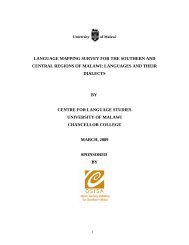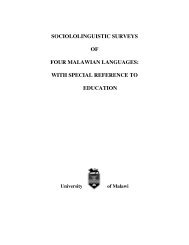languages and area spoken for chitipa - Centre for Language Studies
languages and area spoken for chitipa - Centre for Language Studies
languages and area spoken for chitipa - Centre for Language Studies
You also want an ePaper? Increase the reach of your titles
YUMPU automatically turns print PDFs into web optimized ePapers that Google loves.
7.0 CONCLUSION<br />
The aim of this study was to determine the number of <strong>languages</strong> <strong>spoken</strong> in the northern<br />
region, where they are <strong>spoken</strong> <strong>and</strong> number of speakers of these <strong>languages</strong>. The study has<br />
identified fifteen <strong>languages</strong> <strong>spoken</strong> in the northern region of Malawi with Citumuka as<br />
the main language <strong>spoken</strong> in at least each of the districts of the region. The study has also<br />
identified dialects <strong>for</strong> some <strong>languages</strong> <strong>spoken</strong> in the region. For example, Citumbuka has<br />
Phoka <strong>and</strong> Henga as its dialects while Nyiha has Nyika as a dialect. The most dominant<br />
language of Chitipa is Chilambya with other <strong>languages</strong> such as Citumbuka, Nyiha/Nyika,<br />
Ndali/Sukwa, Chinamwanga, Chimambwe, Chichewa, Chibemba <strong>and</strong> other minor<br />
<strong>languages</strong>/dialects. In Karonga, the most dominant <strong>and</strong> prestigious language is<br />
Kyangonde with Nyakyusa <strong>and</strong> Chinkhonde as dialects. Chitonga is the most dominant<br />
language in Nkhatabay where Citumbuka is also <strong>spoken</strong> in some parts. Rumphi is<br />
predominantly Citumbuka speaking district. Mzimba, previously, a Ngoni speaking<br />
district is now predominantly a Citumbuka speaking district with very little population of<br />
Ngoni speakers. The Mzimba Tumbuka, however, is heavily influenced by Ngoni.<br />
The study also sought to find people’s views in regards to the language(s) to be used as<br />
media of instruction <strong>and</strong> taught as subjects in lower classes of primary schooling. The<br />
popular choice of language to be used in schools was the most dominant language in the<br />
<strong>area</strong>/district. The situation is more complex in Chitipa which has at least one dominant<br />
language in every Traditional Authority <strong>and</strong> people their own <strong>languages</strong>. In the other<br />
districts where only one language was dominant, it was preferred to be used in schools<br />
other than <strong>languages</strong> that have minority speakers.<br />
There is also a high degree of loyalty to people’s own <strong>languages</strong>. These are the <strong>languages</strong><br />
people use in their everyday endevours <strong>and</strong> there<strong>for</strong>e act as their cultural identity. The<br />
use of <strong>for</strong>eign <strong>languages</strong> among the locals in public domains is often resented as it creates<br />
communication barriers <strong>and</strong> it is seen as an infringement on their right to use the<br />
language of their heritage.<br />
27





